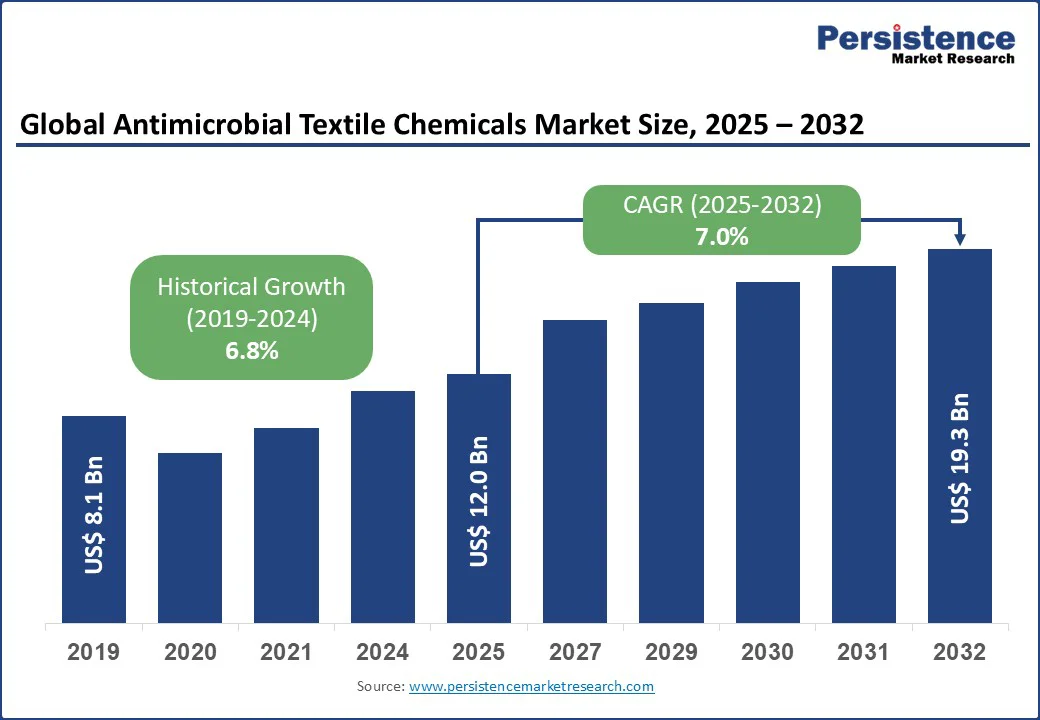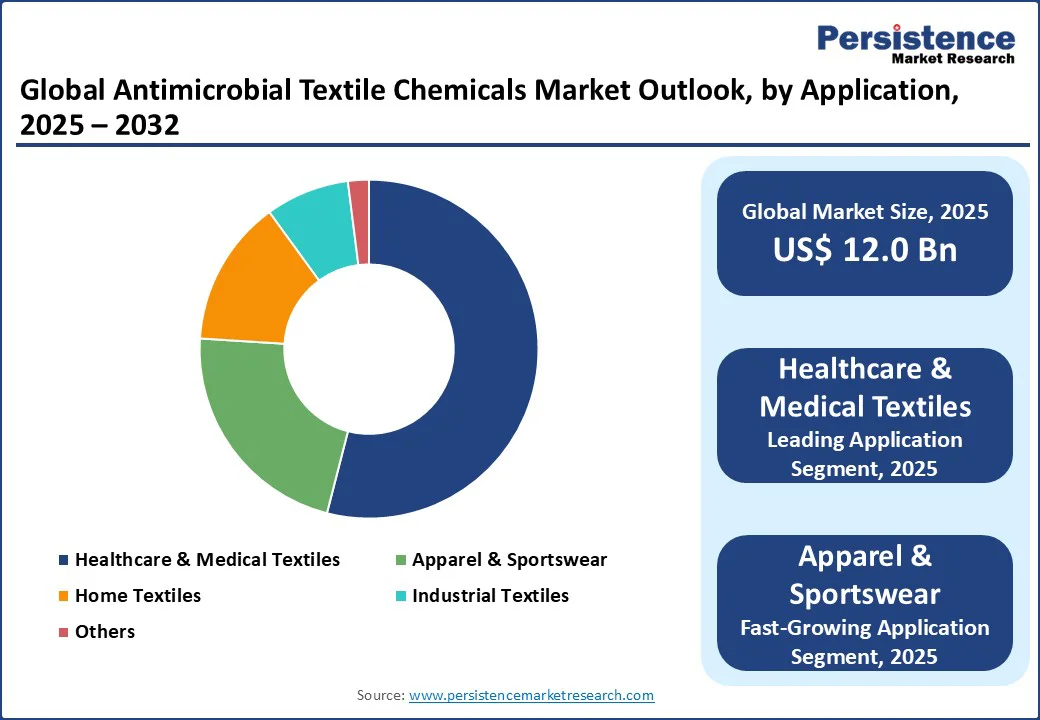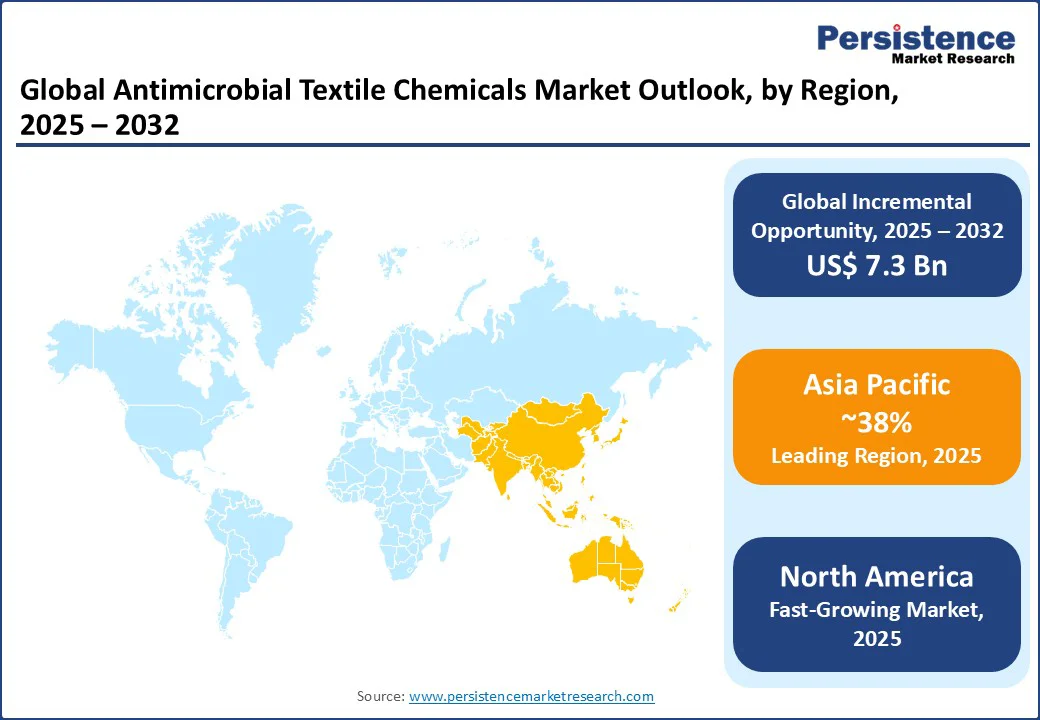ID: PMRREP12070| 197 Pages | 2 Sep 2025 | Format: PDF, Excel, PPT* | Chemicals and Materials

The global Antimicrobial Textile Chemicals Market is projected to grow from US$ 12.0 Bn in 2025 to US$ 19.3 Bn by 2032, registering a CAGR of 7.0% during the forecast period from 2025 to 2032.
The antimicrobial textile chemicals market has experienced robust growth, driven by increasing demand for hygienic and infection-resistant textiles in healthcare, rising consumer awareness of health and hygiene, and advancements in textile chemical technologies. The growing prevalence of healthcare-associated infections (HAIs), coupled with expanding applications in sportswear, home textiles, and industrial sectors, has significantly boosted market demand.
Key Industry Highlights:

|
Global Market Attribute |
Key Insights |
|
Antimicrobial Textile Chemicals Market Size (2025E) |
US$ 12.0 Bn |
|
Market Value Forecast (2032F) |
US$ 19.3 Bn |
|
Projected Growth (CAGR 2025 to 2032) |
7.0% |
|
Historical Market Growth (CAGR 2019 to 2024) |
6.8% |
Healthcare-associated infections (HAIs) remain a significant concern globally, leading to increased morbidity, mortality, and healthcare costs. Hospitals, clinics, and other medical facilities are prioritizing the adoption of antimicrobial textiles, including surgical gowns, drapes, bed linens, wound dressings, and staff uniforms, to reduce microbial contamination and prevent the spread of pathogens. For instance, Johns Hopkins Hospital in the U.S. implemented silver-treated surgical gowns and bed linens, which helped reduce bacterial contamination in patient care areas.
The COVID-19 pandemic further heightened awareness regarding hygiene and infection prevention, accelerating the adoption of antimicrobial treatments in medical textiles. Advanced antimicrobial agents, such as silver-based compounds, quaternary ammonium compounds, and chitosan, are integrated into textiles to provide long-lasting protection against bacteria, fungi, and viruses. For instance, hospitals in Germany and Italy began using silver-coated masks and drapes during the pandemic to enhance infection control measures. Additionally, stringent regulations from healthcare authorities, such as the CDC’s guidelines in the U.S., along with rising investments in hospital infrastructure, encourage the deployment of antimicrobial textiles. This trend enhances patient safety, reduces the burden on healthcare staff, and positions the infection control segment as a critical growth driver for the antimicrobial textile chemicals market.
The growing concern over the environmental and health impacts of chemical agents used in textile treatments. Many antimicrobial compounds, including triclosan, quaternary ammonium compounds (QACs), and some silver-based nanoparticles, can persist in the environment and accumulate in water bodies, potentially harming aquatic life and disrupting ecosystems.
For instance, studies in Europe have detected triclosan residues in rivers and lakes, raising alarms over its ecological impact. Improper disposal or excessive use of these chemicals during textile production may lead to soil and water contamination, attracting regulatory and public scrutiny.
From a health perspective, prolonged exposure to certain antimicrobial agents has been linked to skin irritation, allergic reactions, and potential disruption of human microbiota, particularly among healthcare workers and consumers using treated textiles regularly.
For instance, strict regulations in Europe and North America, such as the REACH framework, impose limits on hazardous antimicrobial compounds, increasing compliance costs for manufacturers. These concerns limit market growth, prompting the adoption of bio-based antimicrobial agents and investment in sustainable, eco-friendly textile treatments.
Advancements in eco-friendly antimicrobial agents present a significant growth of the antimicrobial textile chemicals market. With increasing regulatory pressure and consumer demand for sustainable products, manufacturers are investing in the development of biodegradable and non-toxic antimicrobial agents, such as chitosan-based compounds and plant-derived antimicrobials. These innovations aim to address environmental concerns while maintaining high efficacy against pathogens.
For instance, chitosan, derived from natural sources such as crustacean shells, offers antimicrobial properties with minimal environmental impact, making it an attractive alternative to synthetic chemicals.
Research into nanotechnology-based antimicrobial coatings, such as silver nanoparticles with controlled release mechanisms, is also gaining traction. These advancements improve the durability and effectiveness of antimicrobial treatments while reducing the amount of chemicals required, thereby lowering environmental impact. Additionally, innovations in application techniques, such as microencapsulation, enhance the longevity of antimicrobial effects on textiles, improving consumer satisfaction and reducing the need for frequent reapplication. These developments attract investments from both established companies and startups, driving market expansion and creating opportunities for differentiation in a competitive landscape.
Silver-based agents dominate the antimicrobial textile chemicals market and is expected to account for approximately 47% of the market share in 2025. Their dominance stems from their broad-spectrum antimicrobial efficacy, long-lasting effects, and widespread use in healthcare and apparel applications. Silver-based agents, such as silver nanoparticles and silver salts, are highly effective against bacteria, fungi, and viruses, making them a preferred choice for medical textiles and sportswear. Their compatibility with various textile materials and ability to withstand multiple wash cycles further enhance their market position.
The chitosan segment is the fastest-growing, driven by increasing demand for eco-friendly and biodegradable antimicrobial agents. Chitosan’s natural origin, non-toxicity, and efficacy against a wide range of pathogens make it a compelling alternative to synthetic chemicals such as triclosan. The growing focus on sustainability, particularly in Europe and North America, is accelerating the adoption of chitosan-based treatments in home textiles and apparel, with significant growth potential in emerging markets.
Liquid/solution forms hold the largest market share, accounting for approximately 55% of revenue in 2025. Their dominance is driven by their ease of application, versatility, and widespread use in industrial textile manufacturing processes. Liquid antimicrobial solutions are commonly applied through spraying, padding, or dipping techniques, ensuring uniform coverage on textiles used in healthcare, home furnishings, and sportswear. Their compatibility with large-scale production further supports their market leadership.
Powder/Granules forms are the fastest-growing segment, fueled by advancements in application technologies and increasing demand for durable antimicrobial treatments. Powder-based antimicrobial agents are increasingly used in coating processes for industrial textiles, offering enhanced durability and cost-efficiency. The rise in demand for antimicrobial finishes in technical textiles, particularly in the Asia Pacific, is driving the rapid adoption of this segment.
Healthcare & medical textiles lead the antimicrobial textile chemicals market, holding a 54% share in 2025. The segment’s dominance is driven by the critical need to prevent HAIs in healthcare settings, where textiles such as bed linens, gowns, and curtains are treated to ensure infection control. The global rise in healthcare expenditure and stringent hygiene regulations, particularly in North America and Europe, further boost the adoption of antimicrobial chemicals.
The apparel & sportswear is the fastest-growing, driven by increasing consumer demand for odor-resistant and hygienic clothing. The rise in fitness-conscious lifestyles, coupled with growing awareness of hygiene in sportswear, has spurred demand for antimicrobial treatments in athletic apparel. Innovations in durable and wash-resistant antimicrobial finishes are further accelerating adoption, particularly in the Asia Pacific, where the sportswear market is expanding rapidly.

North America is emerging as the fastest-growing market for antimicrobial textiles, driven by several key factors. A primary growth driver is the increasing consumer awareness about hygiene and health, which has heightened demand for products that prevent bacterial growth and reduce the risk of infections. Consumers are increasingly seeking textiles that offer added protection in daily life, ranging from clothing to home furnishings.
Additionally, the rising adoption of antimicrobial textiles in healthcare settings is a prominent factor. Hospitals, clinics, and other medical facilities are blending antimicrobial fabrics into surgical gowns, bed linens, and uniforms to maintain high standards of hygiene and reduce hospital-acquired infections. Additionally, home textiles, including beddings, upholstery, and towels, are witnessing growing demand as households prioritize cleanliness and health-conscious living environments. Technological advancements in textile manufacturing and supportive regulatory frameworks in North America further encourage market growth. The combination of consumer awareness, healthcare adoption, and innovation in textile solutions positions North America as a rapidly expanding market with a strong potential for continued growth in the coming years.
Europe holds a significant share in the antimicrobial textile chemicals market, driven by advanced healthcare systems, stringent regulatory frameworks, and growing adoption of sustainable textile solutions. Leading countries include Germany, the UK, and France. Germany benefits from its strong chemical and textile industries, with companies such as BASF investing in innovative antimicrobial formulations. The UK’s market growth is supported by rising healthcare expenditure and government initiatives promoting infection control in hospitals. France’s market is driven by advancements in eco-friendly textile treatments and a focus on sustainable manufacturing practices.
The EU’s stringent regulations, such as REACH and the Biocidal Products Regulation (BPR), ensure high-quality and safe antimicrobial chemicals, though compliance increases production costs. The region’s focus on sustainability, coupled with growing demand for antimicrobial textiles in healthcare and home applications is driving a steady market growth from 2025 to 2032.
The Asia Pacific region is projected to dominate the global antimicrobial textile market in 2025, holding a substantial 38% market share. This leadership is largely attributed to the region's position as a global hub for textile manufacturing, with countries such as China and India playing pivotal roles. These nations benefit from well-established infrastructure, abundant skilled labor, and a strong industrial base, which collectively facilitate large-scale production and innovation in textile technologies.
Additionally, rising consumer awareness about hygiene and health has significantly driven demand for antimicrobial textiles across multiple applications, including apparel, healthcare, and industrial sectors. In healthcare, antimicrobial textiles are increasingly used in hospital linens, surgical gowns, and protective clothing to minimize the risk of infections. In apparel, consumers are seeking fabrics that prevent odor and bacterial growth, especially in sportswear and everyday clothing. Industrial applications, such as protective uniforms and workwear, also contribute to regional demand.
Government initiatives promoting textile exports, coupled with investment in research and development of advanced functional textiles, are reinforcing the region’s dominance. The Asia Pacific’s combination of manufacturing capabilities, technological advancements, and high market demand ensures its leading position in the antimicrobial textile industry through 2025.

The global antimicrobial textile chemicals market is characterized by intense competition, regional strengths, and a mix of international and local chemical manufacturers. In developed regions such as North America and Europe, large firms such as Milsuch asn & Company, DuPont, and BASF dominate through scale, advanced R&D capabilities, and established partnerships with textile manufacturers.
In the Asia Pacific, rapid growth in textile production, increasing demand for hygiene-enhancing fabrics, and rising consumer awareness are attracting significant investments from both international players, such as Polygiene Group AB and Sanitized AG, and regional leaders. Companies are focusing on product innovation, sustainability, and strategic alliances with textile producers to gain a competitive edge.
The development of bio-based, eco-friendly, and multi-functional antimicrobial solutions has emerged as a key differentiator, enabling faster adoption in healthcare, apparel, and industrial applications. Strategic collaborations, acquisitions, and digital-first approaches for supply chain and marketing are further intensifying the competitive landscape. Overall, the industry exhibits a dual nature, consolidated at the top by global giants while remaining fragmented across numerous regional and niche players catering to local preferences and cost-sensitive segments.
The global antimicrobial textile chemicals market is projected to reach US$ 12.0 Bn in 2025.
The rising demand for infection control in healthcare settings is a key driver.
The antimicrobial textile chemicals market is poised to witness a CAGR of 7.0% from 2025 to 2032.
Advancements in eco-friendly antimicrobial agents, such as chitosan and nanotechnology-based coatings, are a key opportunity.
Milsuch asn & Company, DuPont, BASF, Polygiene Group AB, and Sanitized AG are key players.
|
Report Attribute |
Details |
|
Historical Data/Actuals |
2019 - 2024 |
|
Forecast Period |
2025 - 2032 |
|
Market Analysis |
Value: US$ Bn, Volume: As Applicable |
|
Geographical Coverage |
|
|
Segmental Coverage |
|
|
Competitive Analysis |
|
|
Report Highlights |
|
|
Customization and Pricing |
|
By Product Type
By Form
By Application
By Region
Delivery Timelines
For more information on this report and its delivery timelines please get in touch with our sales team.
About Author